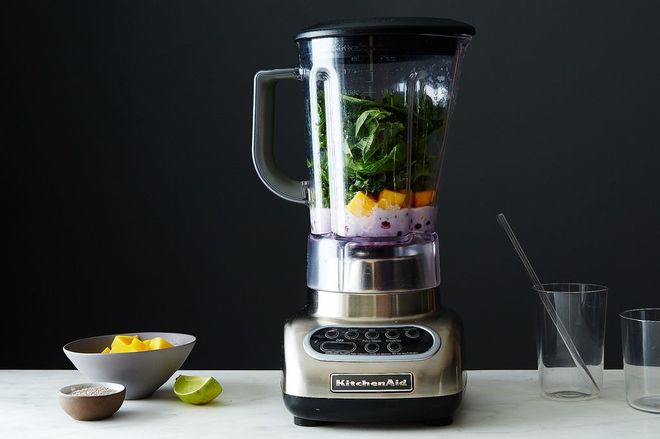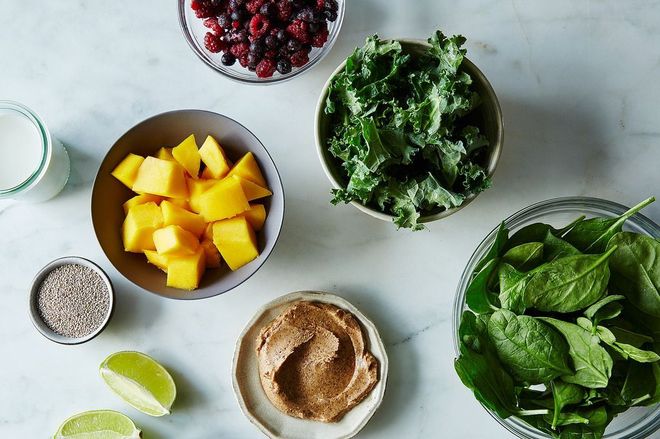Smoothies should be so simple: No cooking, just blending. What could go wrong? But they're all too often watery, flavorless, or vegetal.
No more, we say! You can easily improve your relationship with your blender. If you're on the "Drink one smoothie every day" resolution track, we're here to support you — and give you easy fixes when your whizzing and whirring go awry.

Photo by James Ransom.
Here are 9 smoothie problems you might face on the regular — and how to solve them.
* * *
How to fix your smoothie if it's...
1. Too watery.
Add more fruit (preferably frozen!); something to boost the creamy factor (like nut butter or tahini or pulverized oats or thick yogurt or any of the ingredients listed under problem 4); and a small amount of flavor-saturated liquid, like fruit juice. A small pinch of salt and a generous pinch of a spice like cinnamon or cardamom can also help with resuscitation.
Going forward, use frozen fruit instead of ice cubes (which is also the best way to consume strawberries in the depths of winter). Frozen bananas, in particular, are a smoothie M.V.P. If they're creamy enough to blend into ice cream, you know they'll add richness to smoothies. Frozen pineapple and mango also work well — and they avoid the graininess and unpleasant hard bits that can sometimes come from berries.
And, what's more, a weakling blender will have an easier time pulverizing frozen fruit than it will crushing ice cubes, which will lead to a better texture.

Photo by James Ransom.
If you don't have frozen fruit on hand and are going the ice route, trying adding pre-crushed ice to your smoothie at the final blend. You'll decrease the risk of warming the ice into water.
And since another typical cause of watery smoothies is... water itself, try supplementing with kefir, which has the same tang of yogurt without the thickness, sweetened with a couple of tablespoons of fruit juice.
2. Too healthy-tasting (aka, an accidental liquid salad).
Next time, you'll be less ambitious with the leafy greens, broccoli florets, and carrot juice that made an accidental liquid salad.
For now, add more milk (dairy or non-dairy), half of a frozen banana or crushed or frozen pineapple, and some liquid sweetener, like maple syrup or agave.
Another option: Divide your salad smoothie into an ice cube tray and freeze it.The next time you make a smoothie and want to add something green, throw in a cube or two. Or who knows? Maybe that smoothie will turn into the base for a great curry, stir-fry, or soup.
3. Too "blah."
When your smoothie has all of the looks but none of the flavor, you need to make it less one-note: Add a splash of apple juice or, if you need acid, orange or lemon juice. If you're looking for something bright and sharp, go with grated ginger or a splash of apple cider vinegar; for tang, try Greek yogurt; for sweetness, pitted dates and applesauce. And don't forget about spices, like cinnamon, cardamom, and allspice; extracts (vanilla or almond or mint); and fresh herbs (like mint, basil, or tarragon).
4. Not creamy enough.
This one's easy: Add silken tofu, nut butter or tahini, cooked oatmeal (a tip we found on Serious Eats), Greek yogurt, half an avocado, coconut oil (if the other ingredients aren't so cold that they'll solidify it), or puréed pumpkin, sweet potato, or butternut squash. If your smoothie gets too thick, loosen it up with some not-watery milk.
5. Not blended enough.
If your straw is getting clogged with chunks, it may be because you're not adding the ingredients to the blender in the correct order. (Face palm.) Alton Brown recommends you add the liquid first, towards the bottom (to get the blade whirring smoothly and quickly). To the liquids, add leafy greens, then heavier items like chunks of frozen fruit. Start the blender on low speed, gradually increasing to higher speed, to make sure a vortex forms.
If your greens are still too coarsely chopped for your liking, you can pulverize them with the liquid before adding the other ingredients (or it may be time to invest in a high-speed blender).
6. Too thick.
Add liquid — but not just any liquid. Remember that water will dilute the smoothie, whereas milk, kefir, coconut milk, or any other creamy liquid might change or dull the flavors. Pour in whatever liquid you like best in small amounts, keeping additional ingredients on hand in case the flavors shift.
7. Too gritty.
Sometimes, seeds and protein powders and fibrous stalks can give your smoothie an unpleasant texture. To make it silky-smooth (it is a smoothie, after all), pour your drink through a fine-mesh sieve or a cheese cloth.
8. Too gelled, or separated, or badly behaved in some way.
Give it a scolding. Then make a new plan. If you want to make your smoothie ahead of time, you may have to do some serious shaking (or re-blending) later on.
On separation: Smoothies are suspensions of foods with different densities, so when you let them sit, they'll separate, with the heavier particles settling towards the bottom. If your smoothie is too separated, just give it a refresh in the blender, with just a few pieces of additional ice and flavorful liquid (if needed).
On gelling: If your smoothie is gelling, perhaps you added chia or flax seeds too far in advance. Blueberries, which are very high in natural pectin, are also a culprit of jelly-like smoothies. A re-blend with a little bit of ice and some creamy liquid (if appropriate for the flavor profiles) will likely do the trick. Or, you can enjoy your smoothie with a spoon, as a fruity chia or flax pudding.
9. Too foamy
Sometimes, scummy foam develops at the top of smoothies, making them pretty unpleasant to drink. This foam consists of the insoluble fibers found in the skin of vegetables or fruits. Good news is, there's a way to fix it!
If you've already blitzed up your smoothie and you see foam forming, try blending the smoothie at a very low speed for 10 to 20 seconds longer. (You can also stir the foam back into your smoothie with a long spoon, if it ends up in your cup.) And if foam still forms or persists, try straining the smoothie through a fine-mesh sieve, or pour your smoothie into the cup slowly, using a spatula to hold back the foam in the blender.
To prevent foam to begin with, use fruits and vegetables with soluble fibers, like bananas, peaches, pears, and mangoes. You can also use frozen fruits and vegetables that have soluble fibers, instead of fresh; their icy consistency helps them from causing foam build-up in your smoothie. Last, try adding in a healthy fat that will bond with the insoluble fibers and combine more readily into the smoothie, prior to blending. This can be coconut oil, flaxseed oil, avocado, or a nut butter.
10. Too . . . unfixable.
You can't get it right 100% of the time. But your smoothies seem to always end up less-than-delicious, don't throw away the blender quite yet: Compost what you've got, then follow a different recipe (like any of the ones below!).
Over time, adapt those recipes as you see fit, swapping like for like ingredients to fit your flavor and consistency preferences (liquid for liquid, frozen fruit for frozen fruit, etc.). Smoothies are so perfect for riffing and transforming.


Shares